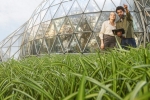
Think differently and act now: How to deliver Australia’s supply of magic dirt
By Clare Pope and Marc Upcroft
Share this article
When the Rubik’s Cube was created in 1974 it was originally known as the ‘Magic Cube’. Designed by Ernő Rubik, the cube has a staggering 43 quintillion potential variations, and it took Rubik a full month to solve his own puzzle the first time around.
Right now, Australia has its own ‘Magic Cube’ to solve: the problem of ensuring enough supply of critical minerals, or ‘magic dirt’ to support the enormous decarbonisation efforts and intentions we are witnessing across the world.
Australia’s critical minerals are key in the global race towards net zero. The shift to clean energy could see demand for critical minerals soar sixfold by 2040 according to the International Energy Agency, representing an unprecedented opportunity for Australia to reap value for stakeholders, reinvent our place in global supply chains, and help redesign the future of the planet.
Yet Australia’s existing supply of critical minerals could fall short as soon as 2025.
As we explain in our upcoming Aussie Mine 2022 report (launching 10 November 2022), miners need to step up their efforts now to further invest in critical mineral exploration and pre production activities. And governments must do more to enable this.
But cracking a Rubik’s cube of this size and complexity will require us to think differently and act now.
How to solve Australia’s critical minerals shortfall?
So, what can Australian mining companies do to boost supply of critical minerals and rare earths? And what can Australian governments do to support that goal?
Given the size of the challenge, it’s clear we all need to think differently. This means developing new ways of working, new approaches and new solutions to address the critical minerals supply/demand gap. It means devising a national plan that extends beyond the upcoming federal/state budgets and election cycles. And it means deeper conversations between miners and governments at every level.
Right now, no idea should be off the table. We need to question the way we do things. So, in the spirit of thinking differently, here a few ‘thought starters’ to consider:
1. What if we built further on the Junior Minerals Exploration Incentive (JMEI)?
The aim of the JMEI program (namely, to encourage investment in small miners carrying out greenfields exploration) can’t be faulted. The scheme, however, is underfunded. JMEI saw just $25 million in credits allocated under the latest round. This, for a sector that’s forecast to deliver a record $344 billion in exports in 2021-2 and creates thousands of jobs.
As a nation, we can afford to invest more. In fact, we can’t afford not to.
Then, there’s the issue of efficiency. The scheme runs on a first-come, first-served basis with the government conceding interest far exceeded available support. Many miners missed out. Anecdotally, some missed out within minutes of the program going live, sharing date stamped emails with the ATO - such is the demand for junior explorers to access the JMEI. Also anecdotally, JMEI tax credits can take until June the following year to be issued.
Consultation on the JMEI is currently open. Let’s take the opportunity to reinvent this and encourage the Australian government to increase it, and perhaps offer targeted JMEI credits for exploration for specific critical minerals.
2. What if we create a critical minerals ESG pricing premium?
Compared to many overseas competitors, Australian miners have strong environmental, social and governance (ESG) credentials. Buying our minerals means choosing ethical supply chains, relatively high environmental standards, and fairer dealings with communities. Surely, this is worth a premium?
S&P Global, for instance, publishes a ‘“green aluminium’” pricing premium, showing customers are willing to pay an extra US$10-15 per tonne for sustainably made aluminium. These sorts of levies are only set to grow as consumers become even savvier about supply chains and provenance.
Economically speaking, premiums work best in a perfectly competitive and balanced market, when consumers take the market price as given. Also, during a shortage when suppliers can dictate terms.
3. What if we reimagine the way we do free trade?
Let’s think big, here. Currently, Australia is playing by (self-imposed) free trade rules that don’t apply to our competitors. What might we do differently?
For a start, Australia’s critical minerals sector is largely export-oriented, with limited onshore processing. What if we introduced European-style onshore processing facilities so we can secure our supply chains?
Or what about extending domestic supply obligations to minerals - currently these are now only applied to oil and gas; and we ask ‘why not to minerals’? For example, the Fuel Security Act 2021 sets out a minimum stockholding obligation for fuel, while the Australian Domestic Gas Security Mechanism can enforce export limits on LNG. Why stop here? We know there’s a clean hydrogen shortage coming, and that hydrogen is a major plank in the global energy transition, so why not protect Australia’s supply now? This applies to other (depletable) natural resources, too.
And while we’re at it, let’s think about strategic reserves and offtake agreements. Offtake agreements are usually a key to unlock project funding, enabling the project to be financed and get its product to market. Many critical minerals markets are relatively immature (at least for our new ways of using them) and subject to volatile or opaque pricing.
What if governments supported financing much-needed critical minerals projects by entering into offtake agreements with miners, or standing in as intermediaries or acting as an underwriter? Underwriting could stabilise the market in its early phase, and enable Australia to hold strategic reserves. At the very least, the government has a role to play when it comes to defence materials.
4. What if we had exemptions from competition laws?
Australia has some of the world’s most stringent competition laws. And while antitrust laws exist for good reason, they can be a stumbling block to beneficial collaboration.
In Europe, antitrust authorities have already begun scrutinising competition rules. For instance, the OECD Competition Committee5 is exploring whether there’s a potential conflict between competition and sustainability goals. Similarly, the European Commission6 launched a public consultation on changing cooperation rules to keep up with the digital and green transition.
So then, is it time to re-visit Australia’s competition laws? Could we, for instance, support stronger collaboration between exploration and development phase projects to help build new markets, shared mineral processing plants and projects. At least in the early stages. The Queensland government should be recognised for its support of vanadium. Collaboration around rare earths is another opportunity that could increase speed in project development.
5. What if we rethink infrastructure?
Improving access to infrastructure is a no-brainer if we want to rapidly scale up national production of critical minerals and rare earths. So, how can we achieve it?
Shared-use infrastructure is one solution. Common ports, railways, and processing plants mean smaller rare earth deposits are suddenly feasible, and smaller mines are viable, too. But what about sharing digital infrastructure? This seems like something worth investing in, too.
Already, we’re seeing governments support critical minerals hubs, such as Australia’s first hub in NSW’s Central West7. These hubs will connect critical minerals mining sites and provide access to renewable energy generation and transmission facilities. Now let’s ask: what more might governments do? Could governments provide additional capital to projects to enable them to build a larger-scale processing facility for other parties to utilise this additional capacity? This could achieve higher efficiency of capital, as well as assisting the development of more projects.
43 quintillion potential solutions
These suggestions are intended as examples of the types of questions we need to ask ourselves and our governments. Just as the Rubik’s Cube has 43 quintillion potential variations, there are infinite possible ways we might solve Australia’s critical minerals shortfall. We need a national conversation between miners and governments if we’re going to solve the Magic Cube of our magic dirt.
1 www.minister.industry.gov.au/ministers/pitt/media-releases/consultation-opens-mining-exploration-program
2 www.minister.industry.gov.au/ministers/pitt/media-releases/consultation-opens-mining-exploration-program
3 www.minister.industry.gov.au/ministers/pitt/media-releases/consultation-opens-mining-exploration-program
4 www.pwc.com.au/mining/global-mine.html
5 www.oecd.org/daf/competition/sustainability-and-competition.htm
6 www.ec.europa.eu/commission/presscorner/detail/en/ip_22_1371
7 www.nsw.gov.au/media-releases/critical-minerals-hub
Contact us


Marc Upcroft
Partner, Assurance, Australian Mining Leader, PwC Australia
Tel: +61 419 629 803













